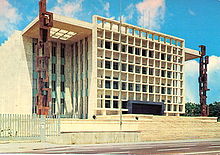- Assembly of Experts
-
Assembly of Experts of Iran
مجلس خبرگان رهبری
Type Type Advice (opinion) Leadership Speaker Mohammad-Reza Mahdavi Kani
since March 8, 2011Members 86 Political groups Combatant Clergy Association
Association of Combatant ClericsElections Last election September 19, 2006 Meeting place 
Assembly of Experts, Tehran, Iran Website http://www.majlesekhobregan.ir/ Iran 
This article is part of the series:
Politics and government of
IranConstitution- Constitution (1979)
- Constitution (1906)
Leadership- Supreme Leader
- Assembly of Experts
- Speaker
Executive- President (List)
- Vice President
- Cabinet
- 90th Government
- Supreme National Security Council
- Secretary
- Supreme Council of the Cultural Revolution
- Chairman
Legislative- Islamic Consultative Assembly
- Speaker
- Expediency Council
- Chairman
- Supreme Audit Court
- City and Village Councils
Judicial- Supreme Court
- Attorney General
- General Inspection Office
- Ministry of Justice
- Human rights
ElectionsPolitical Parties- Political parties in Iran
- Reformists
- Conservatives
Foreign Policy
The Assembly of Experts[1] (also Assembly of Experts of the Leadership) of Iran (Persian: مجلس خبرگان رهبری, Majles-e Khobregan or Majles-e Khebregan-e Rahbari), also translated as Council of Experts, is a deliberative body of 86 Mujtahids (Islamic scholars) that is charged with electing and removing the Supreme Leader of Iran and supervising his activities. Members of the assembly are elected from a government-screened list of candidates by direct public vote to eight-year terms.[2] Current laws require the assembly to meet for at least two days, twice annually.[3][4] The current chairman of the Assembly is Mahdavi Kani, who was elected in March 2011.[5]
Contents
Functions
See also: List of speakers of Assembly of Experts of IranAccording to the Iranian Constitution, the assembly is in charge of supervising, dismissing and electing the Supreme Leader. In the event of his death, resignation or dismissal, the Experts shall take steps within the shortest possible time to appoint a new Leader.[6] "Whenever the Leader becomes incapable of fulfilling his constitutional duties, or loses one of the qualifications mentioned in the Constitution, or it becomes known that he did not possess some of the qualifications initially, he will be dismissed."[7] The assembly has never dismissed a sitting Supreme Leader, and as all of their meetings and notes are strictly confidential, the assembly has never been known to challenge or otherwise publicly oversee any of the Supreme Leader's decisions.[8]
The Experts are to review and consult among themselves concerning Islamic jurists possessing the qualifications of leadership. Constitutionally these criteria include "Islamic scholarship, justice, piety, right political and social perspicacity, prudence, courage, administrative facilities and adequate capability for leadership."[6] In the event they find one of the jurists better versed in Islamic regulations, the subjects of the Fiqh, or in political and social issues, or possessing general popularity or special prominence for any of the qualifications of leadership, they shall elect him as Supreme Leader. Otherwise, in the absence of such a candidate, the Experts shall elect and declare one of themselves as Supreme Leader.[6]
According to Chibli Mallat, a Lebanese lawyer and intellectual, the basis of assembly's election and work is derived from the Shia tradition whereby the shia rank and file, the muqallid, "chose their marja and then the pre-eminent marja emerged by consent among senior clerics."[9]
The assembly gathers every six months. Activities of the assembly include compiling a list of those eligible to become leader in the event of the current leader's death, resignation, or dismissal. This is done by the 107/109 commission.[10] Monitoring the current leader to make sure he continues to meet all the criteria listed in the constitution is done by the 111 commission.[10] Members of assembly report to this commission about the issues concerning the current leader, and the commission can then order an emergency meeting of the assembly. If the commission denies this, the members can ask the general assembly for a vote, and if most of the members of assembly decide, there will be an emergency meeting of the assembly for discussing the current leader. The meetings, meeting notes, and reports of the assembly are confidential and not made available to anyone outside the assembly, except for the sitting Supreme Leader.[10]
The constitution does not specify requirements for members of the assembly, leaving the assembly itself to put limits on who may be a candidate. The assembly has passed laws to require all its members be experts in Fiqh (Islamic jurisprudence),[11] authorizing the Guardian Council to vet candidates for ijtihad proficiency using written and oral examinations. This law is being challenged by the reformists, and their 2006 election campaign included changing this law to allow non-clerics into the assembly, and reforming the law that allows Guardian Council to vet candidates.[12][13]
Currently, the average age of its members is over 60 years, which results in many mid-term elections.
History
See also: Assembly of Experts for ConstitutionThe Assembly of Experts of the Leadership was first elected and convened in 1983. The first Assembly of Experts chose Ayatollah Montazeri as the successor to Supreme Leader Grand Ayatollah Khomeini in 1985. But on Sunday, March 26, 1989 Khomeini dismissed him in a letter: "... you are no longer eligible to succeed me as the legitimate leader of the state."[14] Following the death of Ruhollah Khomeini on June 3, 1989, the Assembly of Experts chose Ali Khamenei to be his successor as Supreme Leader in what proved to be a smooth transition.[15] Initially, a council of three members, "Ali Meshkini, Mousavi Ardabili and Ali Khamenei", were proposed for Leadership. After rejection of a Leadership Council by the assembly, and lack of votes for Grand Ayatollah Mohammad Reza Golpaygani, Khamenei became the Supreme Leader by two third of the votes.[16]
The members of Assembly of Experts are elected every 8 years. It has therefore formed 4 terms, beginning in 1983, 1991 and 1999. The term formed in 2007, will exceptionally last ten years due to the "election aggregation" plan of Iran, put into place to allow the government to run one simultaneous election for both the Assembly of Experts and Parliament, thereby economizing election costs.
First Assembly (1983–1991)
The First Assembly was chaired by Ayatollah Ali Meshkini.
Second Assembly (1991–1999)
The Second Assembly was chaired by Ayatollah Ali Meshkini. Sayed Mohammad Fagheh is one of the member of second assembly of experts from Neyriz Fars.
Third Assembly (1999–2007)
The 3rd assembly was chaired by Ayatollah Ali Meshkini, deputied by Ali Akbar Hashemi Rafsanjani, and Ayatollah Ebrahim Amini. The scribes were Ghorbanali Dorri-Najafabadi and Ahmad Khatami. The members according to each province were:[17][18]
- Ali Akbar Hashemi Rafsanjani
- Meshkini, Ali Akbar
- Mohammad Mohammadi Rey-Shahri
- Mohammad Imami Kashani
- Mohammad Yazdi
- Ahmad Jannati
- Mohammad Reza Tavassoli
- Ghorban Alli Dorri Najaf-Abadi
- Mohammad Taghi Mesbah Yazdi
- Majid Ansari
- Asadi Khansari, Agha Baqer
- Mohsen Kharrazi
- Mohammad Mohammadi Gilani
- Qomi, Mohsen
- Reza Ostadi
- Gholam Reza Rezvani
- East Azarbaijan:
- Mojtahed Shabestari, Mohsen
- Seyed Reyhani, Seyed Abolfazl
- Hashemzadeh Harisi, Hashem
- Ahmadi, Ali
- Oroumian, Ali
- West Azarbaijan:
- Ghaffari Gharebagh, Mir-Akbar
- Pour-Mir Ghaffari, Seyed Mohsen
- Ghoreishi, Mir-Ali Akbar
- Isfahan:
- Yasrebi, seyed Mehdi
- Mazaheri Tehrani, Mirza Hossein
- Hashemi, Seyed Esmail
- Moqtadaie, Morteza
- Mahdavi, Abolhasan
- Khalilzadeh, Bouck Agha ( died & Replaced By Seyyed Hatami, Mir Ebrahim)
- Nourani Taqi Deizaj, Mostafa
- Ilam:
- Mohammadi, Rahim
- Abdonnabi Namazi
- Chahar-Mahaal and Bakhtiari Province:
- Haj Amini Najaf Abadi, Ebrahim
- Ebadi, Seyed Mehdi
- Khazali, Abolghasem
- Hashemi Shahrodi, Seyed Mahmod
- Masomi, Ali Asqar
- Ferdosi Pour, Esmail
- Mehman Navaz, Habiboallah
- Abbas Vaeze Tabasi
- Alami, Hasan
- Khouzestan:
- Shafei, Seyed Ali
- Mousavi, Seyed Mohammad Ali
- Abbasi Fard, Mohammad Reza
- Ali Fallahian
- Abbas Kabi Nasab
- Mohammadi Araghi, Mohsen
- Mousavi, Seyed Esmail
- Alami, Mohammad Ali
- Sistan va Balouchestan:
- Hosseyni, Seyed Mojtaba
- Madani, Mohammad Eshaq
- Fars:
- Dastqeib, Seyed Ali Asqar
- Dastqeib, Seyed Ali Mohammad
- Beheshti, Ahmad
- Hosseyni, Seyed Mohammad Hossein
- Imani, Asadollah
- Qom:
- Seyed Rohani, Agha Mehdi
- Mousavi Pour, Seyed Hasan
- Sheikh Mohammadi, Ali
- Sheikholleslami, Mohammad
- Abdolqader Zahedi
- Ahmadi, Zekrollah
- Zarandi, Hossein
- Seyed Ahmad Khatami
- Hashemian, Mohammad
- Mohammad Ali Movahedi
- Kohgiluyeh and Buyer Ahmad:
- Malek Hosseyni, Seyed Keramatollah
- Noor Mofidi, Seyed Kazem
- Taheri, Seyed Habibollah
- Gilan:
- Aminian, Mokhtar
- Mahfoozi, Abbas
- Ghorbani, Zeinolabedin
- Taskhiri, Mohammad Ali
- Lorestan:
- Taheri Khorram Abadi, Seyed Hasan
- Shahrokhi, Seyed Mohammad Taqi
- Mohseni Garakani, Ahmad
- Mir-Mohammadi, Seyed Abolfazl
- Mazandaran:
- Jabbari, Seyed Saber
- Sadeq Ardeshir Larijani
- Karimi Kalabi, Seyed Jafar
- Rohani Rad, Hadi
- Hormozgan:
- Anvari, Mirza Mohammad
- Saberi Hamedani, Ahmad
- Dabestani, Seyed Abolhasan
- Yazd:
- Khatam Yazdi, Abbas Agha
Fourth Assembly (2007–2015)
Further information: Iranian Assembly of Experts election, 2006The election for the fourth assembly took place on 15 December 2006 and was convened on 19 February 2007. Akbar Hashemi Rafsanjani was re-elected as chairman. The changes in the presiding board from the 3rd assembly was the replacement of Mohammad Yazdi with Ebrahim Amini, who has retired, as the 2nd deputy chairman; and election of Hassan Rohani as provisionist.[19]
Of particular note is the victory of pragmatist Ayatollah Rafsanjani list, over hard-line candidates associated with President Mahmoud Ahmadinejad for positions in the 86-member Assembly of Experts. Rafsanjani lost out to Ahmadinejad in the 2005 election runoff for President. Ayatollah Rafsanjani won nearly twice as many votes as hard-liner Ayatollah Mohammad Taqi Mesbah Yazdi. Final results for the Assembly of Experts showed that more than 65 candidates close to Mr. Rafsanjani were elected. At 60 percent, voter turnout was much higher than in previous years.
The top 16 candidates in Tehran were announced as:
Constituency Name Party Votes Tehran Akbar Hashemi Rafsanjani 1,564,197 Ali Meshkini 839,834 Mohammad Yazdi 823,602 Mohammad Emami-Kashani 823,308 Mohsen Kazeroun (Kazerouni) 800,973, Ahmad Jannati 787,908 Mohammad Taqi Mesbah-Yazdi 726,498 Hassan Rohani 669,990 Mohsen Qomi 625,428 Seyyed Mohsen Aqa Mir Mohammad Ali (Kharrazi) 618,752 Qorbanali Dorri-Najafabadi 595,893 Mohammad Baqer Baqeri (Baqeri Kani) 536,928 Reza Ostadi-Moqaddam 520,674 Mohammad Mohammadi Davi-Saraei (Mohammadi Gilani) 520,626 Seyyed Mohammad Hassan Marashi (Shoushtari) 501,222 Abdolnabi Namazi 492,146 Qom Mohammad Momen n/k (Tehran Source) (ISNA) (Qom) In July 2007 Meshkini died. Ayatollah Rafsanjani was elected his successor as chairman, beating Ayatollah Ahmad Jannati, an ally of President Mahmoud Ahmadinejad, by 41 to 30 votes.[5] After the disputed results of the June 2009 Iranian presidential election were certified by Supreme Leader Ali Khamenei, Chairman Rafsanjani was reported to have called a meeting of the Assembly of Experts, as they have the constitutional power to hire and fire the Supreme Leader.[20]
Criticism
Iran's assembly of experts has been subject to many criticisms with respect to its structure and function. The assembly for instance has never invited the leader to its meetings. Iran's leader has never been asked to offer a report of his performance over the last few decades. Instead the members of the assembly met with the leader on several occasions to have his advice. The assembly has very few meetings annually and the members mainly discuss subjects not related to their duties, as commenting on the president and government's policies and Iran's foreign policy.[21] Even some conservatives admitted the weakness of the Assembly's performance. In 2006, Mohammad Reza Bahonar, 7th parliament's first Vice Speaker said that the Experts Assembly should present a report on its performance so that the people realize the institution’s importance.[22] As all of their meetings and notes are strictly confidential, the Assembly has never been known to challenge any of the Supreme Leader's decisions.
References
- ^ :: www.Majlesekhobregan.ir ::. -> Magazines -> Islamic Government
- ^ http://www.dur.ac.uk/resources/iranian.studies/Policy%20Brief%201.pdf
- ^ http://www.khobregan.ir/persian/ashnaee/07.htm
- ^ Robin Wright, The Last Great Revolution: Turmoil and Transformation in Iran, Alfred A. Knopf, 2000
- ^ a b Rafsanjani to lead key Iran body, BBC, 2007-09-04, accessed on 2007-09-04
- ^ a b c Constitution of Islamic Republic of Iran article 109
- ^ Constitution of the Islamic Republic of Iran Article 111
- ^ "Iran Announces Second Extension of Voting," Reuters, Oct. 23, 1998.
- ^ Legitimation Crisis. INTERVIEW of Chibli Mallat By GARETH SMYTH in Beirut accessed 9-July-2009
- ^ a b c Discussion and assembly website
- ^ http://www.khobregan.ir/persian/ashnaee/09.htm
- ^ آفتاب - شورای مشورتی اصلاح طلبان برای شوراها
- ^ موسوی لاری و تشريح برنامه های مجمع روحانيون در خبرگان
- ^ http://www.irvl.net/Translation%20of%20Ayatollah%20Khomeini's%20Letter%20Dismissing%20Montazeri.htm
- ^ Background Note: Iran
- ^ http://www.khobreganrahbari.com/modules.php?name=News&file=article&sid=76, http://www.iran57.com/Rafsanjani%20T%20dar%20sal%2068%20mokhalef%20rahbarie%20fardi'%20Ilna%2016%20Azar%201385.doc
- ^ Islamic Republic of Iran Members of Assembly of Experts
- ^ http://www.irvl.net/Assembly%20of%20Experts.htm
- ^ http://www.rajanews.com/News/?6236, http://www.rajanews.com/News/?6261, http://www.aftabnews.ir/vdcivyat1wayw.html
- ^ Borger, Julian; Black, Ian (June 14, 2009). "World leaders urged by Iran's opposition party to reject Ahmadinejad's alleged victory". The Guardian. http://www.guardian.co.uk/world/2009/jun/14/iran-ahmadinejad-mousavi-elections-result. Retrieved June 17, 2009.
- ^ رادیو زمانه | گوي سياست | GS06 - ایران | رييس بعدي مجلس خبرگان كيست؟
- ^ http://iran-daily.com/1385/2680/pdf/i2.pdf
External links
- دبیرخانه مجلس خبرگان رهبری
- Assembly of Experts - Official Website
- Assembly of Experts in the Constitution of Islamic Republic of Iran
- Understanding Iran's Assembly of Experts from Durham University
- Results of Assembly of Experts elections in 6 provinces
- Results of Assembly of Experts elections in four provinces
- Results of Assembly of Experts elections in some provinces
- Iran Electoral Archive - Assembly of Experts
Unicameral legislature of Islamic Republic of Iran Overseeing bodies:
• Assembly of Experts • Guardian Council • Expediency Council •Coordinates: 35°41′16.82″N 51°23′58.72″E / 35.6880056°N 51.3996444°E
Categories:- Politics of Iran
- Government of Iran
- Constitution (1979)
Wikimedia Foundation. 2010.
